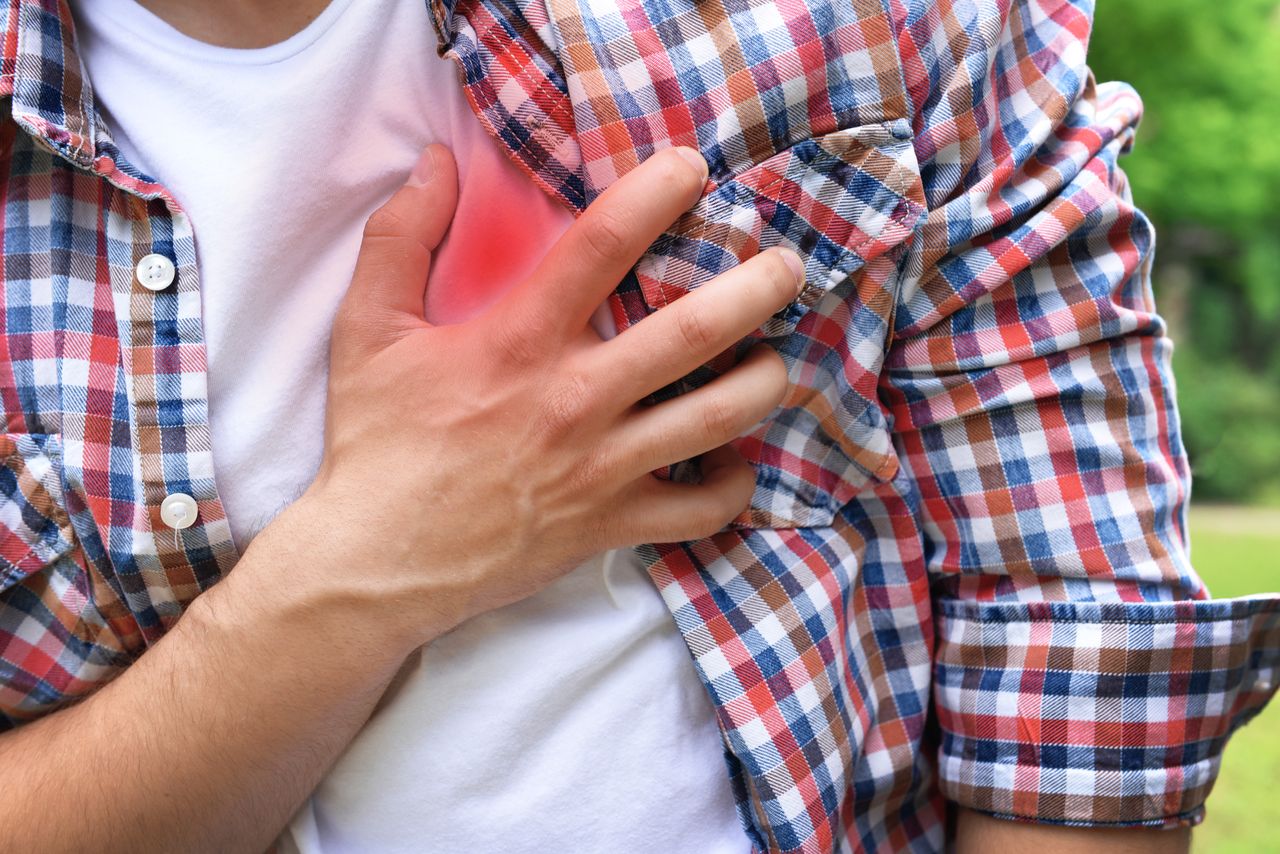[ad_1]
A heart attack, medically known as myocardial infarction, arises when the heart muscle doesn’t get enough blood. It is a medical emergency caused by a blockage in the blood flow to the heart. Like all other muscles, the heart muscle requires a constant blood supply. When there is not enough blood flowing to the heart, the tissue of the heart becomes deprived of oxygen and dies. If not treated immediately, the heart muscle becomes weak and begins to die, and this is a heart attack. Providing emergency medical care helps prevent or reduce the extent of the damage.
Movies and dramas always show heart attacks as sudden and intense. However, most of them start slowly, with mild chest discomfort and pain. Heart attack symptoms vary between women and men. In men, the early signs include a squeezing sensation within the chest followed by upper body pain and dizziness. Women usually don’t experience any chest pain like men. Instead, they feel overwhelming fatigue, anxiety, and sleep disturbances. Trust your instincts since each heart attack is different.
Heart attacks are not exclusively for the older population. It affects a considerable proportion of younger adults as well. But being physically active and following a balanced diet keeps your heart in good condition. In addition, lifestyle plays a significant role in determining a longer, healthier life.
Warning Signs and Symptoms of a Heart Attack
You’ll be able to act fast if you’re more aware of the risk factors and signs. The better you know, the easier it is to understand what’s going on with your heart. So watch out for these common signs of a heart attack.
Chest Discomfort
Discomfort in the centre or the left side of the chest is the most common symptom of a heart attack. It lasts longer than a few minutes, then disappears and reappears. Chest discomfort is marked by pressure, tightness, and pain in the chest. Some people say it feels like an elephant is sitting on them. At the same time, some have reported burning or pinching sensations. Chest discomfort due to a heart attack can occur anytime and anyplace, irrespective of whether you’re resting or doing any physical activity.
Shortness of Breath
Shortness of breath may occur before or during chest pain. Sometimes it may be the only heart attack symptom you experience. Even doing simple activities becomes difficult. For example, walking a short distance would leave you tired and unable to catch your breath. Shortness of breath and fatigue are common heart attack signs among women.
Upper Body Discomfort
Feeling pain in areas of the upper body such as the arms, stomach, jaw, or neck is another warning sign. The pain starts from the chest and spreads towards the left side of the upper body. It is a classic heart attack symptom. In addition, women are more likely to experience upper back pain, nausea, stomach pain, heartburn, or indigestion.
Feeling Lightheaded
Dizziness or lightheadedness makes you lose balance and feel unsteady. You may also be breaking into a cold sweat. If it’s accompanied by shortness of breath and chest pain, immediately seek medical help. It indicates that your blood pressure has fallen, and the heart cannot pump blood efficiently, triggering a heart attack.
Fatigue
A heart attack puts a lot of stress on your heart, leading to extreme exhaustion. Fatigue may begin months before a heart attack. If you’re feeling exhausted for no reason, it’s time to see a doctor. Fatigue in women is always accompanied by something else. It could be chest pain, indigestion, shortness of breath, and chest pressure.
Heart Palpitations
Heart palpitations or irregular heartbeat could signify you have a heart attack. The heartbeat becomes out of rhythm, creating a sense of anxiety and throbbing. If the changes in heart rhythm are followed by chest discomfort, dizziness, and intense sweating, then it’s a confirmation of a heart attack. Heart palpitations are often described as a throbbing or pounding feeling in the neck region.
Other Symptoms and Signs
A lot of things happen before and during a heart attack. For example, some might be suffering from a long-lasting cough with pink or white mucus. Another sign would be swollen ankles, feet, and legs. They all indicate that the heart is not pumping effectively and is falling behind the body’s demands.
Causes and Risk Factors of Heart Attack
Coronary Artery Blockage
The coronary arteries supply oxygen-rich blood to your heart. When these arteries are blocked due to plaque’s fatty deposits, the blood flow to the heart reduces. It leads to a heart attack. In addition, the plaque may rupture during a heart attack and form a blood clot. It further blocks the passage of blood to the heart and makes the condition worse. A heart attack may occur from complete or partial coronary artery blockage.
Coronary Artery Spasm
Another reason that heart attacks occur is a spasm of the arteries to the heart – the coronary arteries. The spasm of the muscles of these vessels block the flow of blood, oxygen and nutrients to the muscle of the heart. This triggers the same death of the muscle cells of the heart aka a heart attack. The extent of the damage to the muscle of the heart is usually determined by the amount of time the arteries have been in spasm and how soon, and effectively, it was treated. Fortunately, coronary artery spasms are rare and mainly occur due to an exposure to illicit drugs or tobacco. Drugs that act as stimulants like amphetamines or cocaine are the most common causes of spasm-induced heart attacks.
Genetics
Heart attack can be an inherited condition as well. Look into the family history. If your grandparents, parents, or siblings have had heart attacks, you might be at higher-than-average risk.
Family genes matter because they control every aspect of your heart and its functions. Moreover, if you have a close family member with diabetes, high cholesterol, or high blood pressure, they can also have an elevated risk for inherited cardiac conditions.
High Blood Cholesterol
Blockage of the arteries to the heart most commonly occur due to the process of atherosclerosis. Atherosclerosis is the deposition of cholesterol and fat in the inner layers of the heart – turning it yellow. High levels of cholesterol like LDL-cholesterol (the most common type of cholesterol deposited) are, therefore, big risk factors for heart attacks. LDL cholesterol, named bad cholesterol, blocks arteries – that leads to a deposition of fat, cholesterol particles and calcium – and disrupts the flow of blood to the heart. These waxy layers of cholesterol on the inner surface of the coronary arteries instigate the occurrence of clots and lead to heart attacks and strokes. Heart attacks due to cholesterol are often caused by unhealthy lifestyle choices – in both diet and exercise. However, there are also genetic causes for high cholesterol.
Age
Age is one of the most clear risk factors for heart attacks. People over the age of 65 are the most vulnerable to these conditions as they have experienced decades of cholesterol deposition in their arteries. However, this does not mean that younger people need not be cautious. From the age of 45, men need to be more alert to the possibility of heart attacks, and as for women, they need to have regular tests done from the age of 55.
Existing Medical Conditions
There are many other medical conditions that can increase your risk for heart attacks. A few of the most common ones are obesity, diabetes, high blood pressure (aka hypertension), lupus, rheumatoid arthritis, and metabolic syndrome. These conditions can double or triple a person’s risk of heart attacks. However, losing weight by healthy diet and moderate exercise can often reverse some of these medical conditions and subsequently increase your cardiovascular health
Treatment for Heart Attack
Medications
The first-line treatment usually includes clot busters, nitroglycerin, beta-blockers, and statins. The clot busters are administered to dissolve the clots responsible for blood flow blockage. Doctors use nitroglycerin to treat the chest pain associated with a heart attack. Beta blockers are another important medication. They reduce the effort of the heart when its blood supply is blocked and thus protects the heart from further damage. It is one of the most effective medications as it helps protect you from dying – now and in the future.
Coronary Angioplasty
Angioplasty surgery opens up the blocked artery by inserting a stent (special metal tube) into the blocked vessel, thus keeping it open for the blood to continue flowing through. It is highly beneficial as angioplasty treats heart attacks without resorting to open-heart surgery.
Bypass Surgery
Doctors might perform emergency bypass surgery during a heart attack. Sometimes, it’s performed 3-4 days after a heart attack. Bypass surgery restores the blood flow to your heart by directing it through a new section around the blocked arteries.
Cardiac Rehabilitation
Cardiac rehabilitation programs aid in the recovery process of a heart attack. Not only does it prevent future heart attacks, but it may also treat the associated complications. Cardiac rehabilitation focuses on diet, exercise, and other lifestyle changes to promote a healthy heart.
Will Heart Attack Cause Further Complications?
The complications depend on how much damage a heart attack has caused. However, they can be dangerous if left untreated. The most common complications from a heart attack are:
Arrhythmia
After a heart attack, you’re likely to develop irregular heartbeats because the muscle damage from a heart attack disrupts the cardiac electrical signals. Thus, this complication is also defined as the electrical short circuits of the heart.
Heart Failure
If the extent of damage caused by a heart attack is severe, then the remaining heart muscle fails to pump enough blood to your body. As a result, it can lead to temporary heart failure. However, extensive damage can make it a chronic complication.
Heart Rupture
Heart rupture is a rare complication of a heart attack but is extremely serious. It leads to the rupture or splitting of heart valves, walls, or muscles.
Cardiac Arrest
Sudden cardiac arrest is a heart attack complication that occurs without warning. The heart may stop due to the electrical disturbances in the cardiac system. If not treated immediately, cardiac arrest can be fatal.
How to Prevent Heart Attack?
Be Physically Active
Watch your weight by following a consistent exercise schedule. A physically active lifestyle is the best way to prevent heart attacks. You can start with simple exercises and later increase the intensity. Around 150 minutes of moderate-intensity activities benefit older adults. If you’re in the younger age group, try to get at least 30 mins of vigorous-intensity exercise at least 5 times a week. A study shows that people with higher physical activity levels had a 15-45% reduction in heart attack risk.
Manage Weight
Watch your weight by following a diet enriched with leafy greens, fruits, fatty fish, whole grains, lean animal proteins, and plant-based proteins. Cut back on extra calories, added sugar, trans fat, refined carbs, and saturated fat. They increase body weight and fat buildup, leading to fatty deposits in the artery. Instead, make smart choices eating fewer calories and exercising more. Remember, overweight and obese people are more vulnerable to heart attacks.
Go Tobacco-Free
Everybody knows that tobacco is bad for your entire well-being. Unfortunately, you won’t find anything such as safe tobacco products since tobacco will cause harm to your body for momentary pleasure. Nicotine, the addictive chemical in cigarettes, forces undue stress on your heart and the cholesterol levels will also go out of control. Add a gain -frame as it’s emotionally more effective: Their hearts are two times more resilient to heart attacks after they quit smoking.
Take Medication
If you’re a person with medical conditions like diabetes, high cholesterol, or hypertension, take all the medications as directed. Since these diseases are risk factors for heart attack, it is a significant preventive step to control them firsthand. However, do not take aspirin unless your doctor tells you to do so. In most cases, doctors advise restricting aspirin intake as it increases risk of bleeding in small injuries. Furthermore, if you’ve had a heart attack, taking high doses of aspirin may increase the risk of having another.
Heart-Healthy Foods to Avoid Heart Attack
Can food make a difference in heart attack risk? Yes, they do. In fact, following a heart-healthy diet reduces cholesterol levels, fat, and blood pressure, all of which are risk factors for heart attack. Here are the top five foods to minimise your chances of getting a heart attack.
1. Whole Grains
Multiple studies have found that adding at least two or three servings of whole grains per day reduces the heart attack risk by 20%. You can include barley, oats, brown rice, whole wheat, buckwheat, or quinoa in your daily diet. Following a diet rich in whole grains may lower the risk factors of a heart attack, such as hypertension, bad cholesterol, fat build-up, and diabetes.
2. Berries
Contrary to popular belief, strawberries, blueberries, raspberries, and blackberries support heart health. They are rich in anthocyanins, an antioxidant that fights against heart-damaging stress and inflammation. One study shows that daily intake of strawberries reduces bad cholesterol levels. While eating blueberries were linked with protection against blood clots. The best part? You can fit berries into your snack or desserts as they’re low in calories and sweet in taste.
3. Salmon
Salmon, a fatty fish, is a heart-healthy superfood because it contains healthy fats called omega-3 fatty acids that reduce triglycerides, blood pressure, and heart palpitations. If these conditions are kept in check, the risk of heart attack decreases automatically. Consuming two servings of salmon a week is enough to reap its benefits.
4. Walnuts and Almonds
Replace those unhealthy fats like chips, fries, and cookies with a handful of walnuts or almonds. Nuts are full of monounsaturated fats and fibre, protecting the arteries from inflammation. In addition, they also lower your cholesterol. If your arteries are protected, it eliminates the chief factor of a heart attack.
5. Avocado
Reliable studies have noted the cardioprotective nature of avocado. Avocados help lower bad cholesterol, blood pressure, and lipid, which are factors that significantly raise the risk of a heart attack. Eating one avocado per day is beneficial for those looking to manage cholesterol and steer clear of a heart attack. Moreover, they provide a healthy dose of monounsaturated fats and potassium that aids in heart health.
Final Thoughts
A heart attack occurs when your heart is deprived of enough blood to stay healthy. Heart attack signs are silent signs as they’re easy to ignore. In addition to extreme fatigue, you will experience chest discomfort, upper body pain, shortness of breath, and breaking out in a cold sweat. Chest discomfort is a common warning sign of a heart attack that lasts for more than a few minutes. The chest pressure and squeezing feeling tend to go away and return with greater intensity. It is the stereotypical heart attack sign.
A heart attack may run in your family, meaning it can also be a genetic condition. You can prevent a heart attack by following a balanced diet, quitting smoking, being physically active, and managing your existing medical conditions. Eating healthy and heart-friendly foods helps you to a maximum extent. You can start your heart attack prevention journey by adding whole grains, nuts, avocados, berries, and fatty fish to the diet.
[ad_2]
Source link



